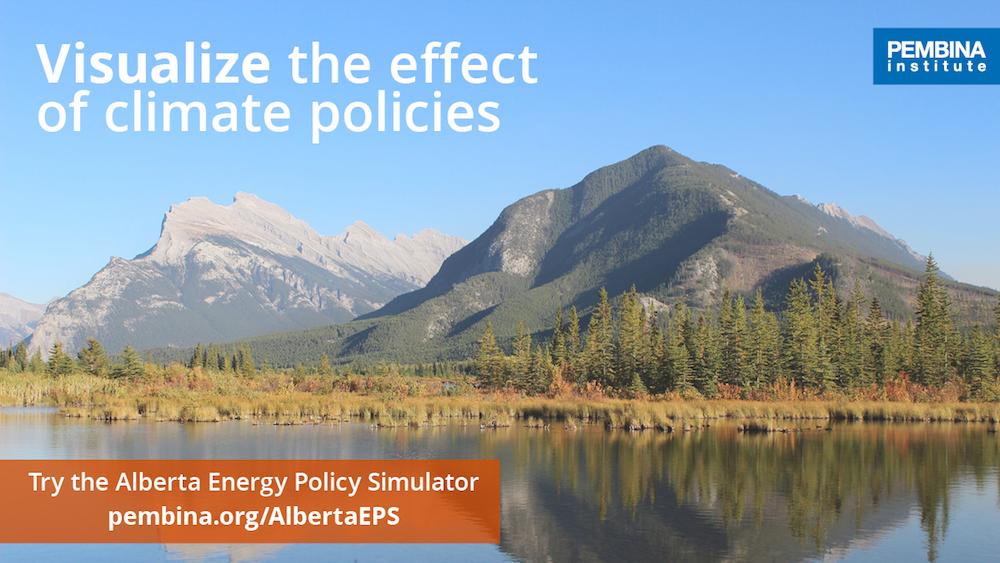CALGARY — In the lead up to the provincial election, Alberta’s energy future is a highly charged topic. To make good choices, Albertans require credible, non-partisan information.
Launching today, Alberta’s Energy Policy Simulator (EPS) is the first tool that allows anyone to visualize the impact of proposed policy ideas on the province’s carbon pollution and energy trajectory. Developed by the Pembina Institute in collaboration with Energy Innovation, Alberta’s EPS is free and open source, and can be run in a web browser or installed on a computer.
Looking at a range of topics including renewable energy, pollution pricing, mass transit, and efficient buildings, users of the tool can gain a deeper understanding of the specific policy actions that parties vying to lead Alberta can take to decrease its climate-destabilizing carbon emissions while increasing Albertans’ quality of life.
Alberta’s EPS builds on the success of Canada’s Energy Policy Simulator, originally launched in 2018. The tool is based on rigorous published data from government entities and other credible sources, and was reviewed by a broad group of policy experts from industry, government, and academia. The release of Alberta’s EPS is a milestone in the Pembina Institute’s ongoing efforts to increase the public’s awareness of how energy policies can be designed to achieve Alberta’s and Canada’s targets for reducing carbon pollution.
Journalists are encouraged to contact the Pembina Institute for an introduction to Alberta’s EPS, how it works, and how it can be used to the assess the effect of existing, proposed, or potential policies on the province’s emissions trajectory. In the coming weeks, the Pembina Institute will be highlighting some of the key findings derived from the tool.
Try out Alberta’s Energy Policy Simulator at pembina.org/AlbertaEPS.
Quick facts
- Alberta’s Energy Policy Simulator allows users to forecast the impact of a combination of more than 50 potential policies, each set to user-specified levels.
- The first free and open-source tool of its kind, Alberta’s EPS comes with three built-in scenarios help to evaluate current and future opportunities:
- Business as usual scenario — shows the energy trajectory of Alberta as of the end of 2015
- Current policy scenario — includes provincial policies implemented since 2016
- Example scenario — adds potential policies to illustrate the effect on the trajectory
- With the user-friendly interface, you can create your own scenario, display results graphically and save, alter, and share different policy packages.
- Extensive online documentation details how the model works.
Quotes
“With new climate policies introduced in the past few years, Albertans can be proud of the fact that we have stabilized our province’s carbon pollution for the first time. However, we still have much work to do and it will take a thoughtful effort. Looking forward, this tool can inform decisions about what we can further do to rein in carbon pollution.”
— Duncan Kenyon, Alberta director, Pembina Institute
“All of us have a stake in Alberta’s energy future. With the release of Alberta’s Energy Policy Simulator, the media, political parties, energy analysts, and the public can test the effectiveness of proposed energy and climate policies and obtain factual information on the impact of policy choices.”
— Benjamin Israel, senior analyst, Pembina Institute
[30]
Join the conversation on Twitter: #AlbertaEPS @Pembina
Note for media: Interviews are available in English and French.
Contact
Stephen Hui
Senior Communications Lead, Pembina Institute
778-987-7654
stephenh@pembina.org
Tw: @StephenHui
About the Pembina Institute
The Pembina Institute is a non-profit think-tank that advocates for strong, effective policies to support Canada’s clean energy transition. We have offices in Vancouver, Calgary, Edmonton, Toronto, and Ottawa. Learn more: www.pembina.org





